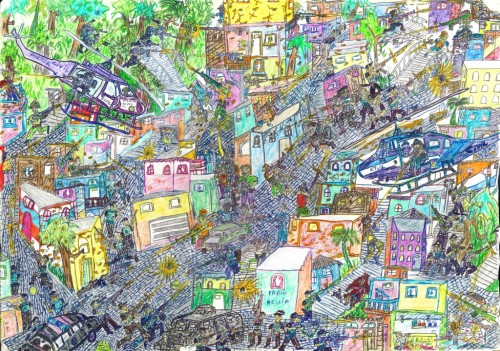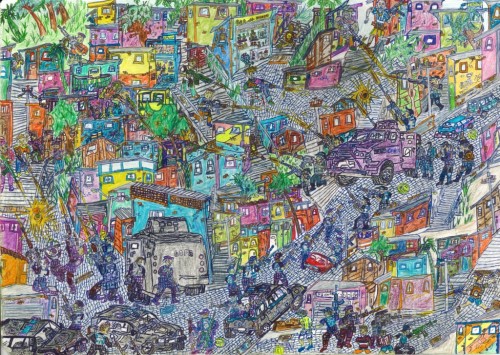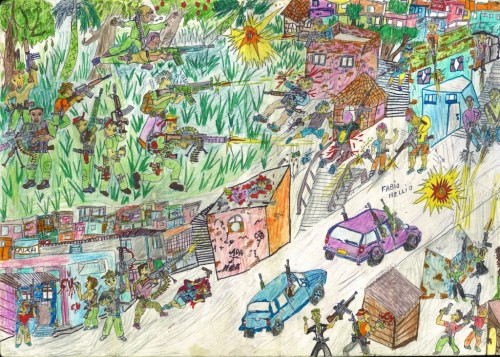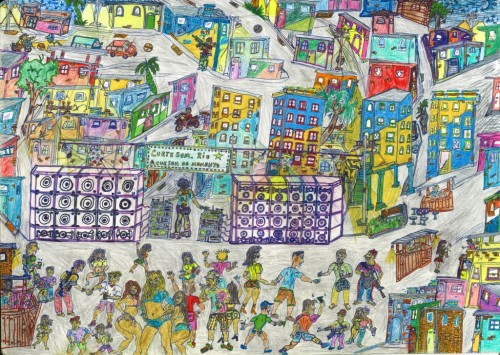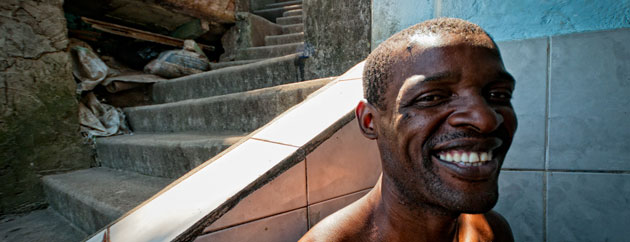
Stories from the Community: The Unique Art of a Former Drug Dealer in a Pacified Rio Favela
08 May, 2012“What I want to show with my drawings is the reality of our community, Santa Marta. These are the stories of life in the favela and they show that there is nothing easy about that life”. For years Fabio Nelio (36) was a drug dealer in a Rio de Janeiro favela. Currently he works in a government construction program and draws to deal with his experiences of drug trafficking.
Santa Marta was the first favela in Rio de Janeiro to be “pacified” by the Unidade de Polícia Pacificadora (UPP), in December 2008. The goal of the pacification – an ongoing process – is to remove armed drug traffic from these poor neighborhoods, increasing public security, both in the official parts of the city and in the unofficial communities (a word most residents prefer over the loaded term favela). At the moment Santa Marta is relatively safe, but how does the pacification influence the life of former drug dealers and their families? With this question in mind I spoke to Fabio Nelio, a former drug dealer from Santa Marta.
“He never had any artistic education, so some people say this is Art Brut or Naïve art. I don’t know much about art, for me drawing is a positive way to show his negative experiences. He is a reporter, judging this war from the inside. He did not just see it, he was part of it,” explains Kadão Costa, music producer and cousin of Nelio.
The large majority of Nelio’s drawings show his past in the drug traffic. We see violent confrontations between dealers and the police, both heavily armed. The colourful, almost childlike way of drawing contrasts strongly with this violence. Nelio explains: “What I want to show with my drawings is the reality of Santa Marta.
I want to show what the confrontations, the police-invasions are really like. These are the stories of life in the favela and they show that there is nothing easy about that life. There are armed conflicts, there is war. But when I complete this theme I also want to show other things: people on their way to work, friends in a bar, a baile funk. This is also part of the life in the community.”
Pacification
“I spent eight years of my life in prison, as a member of the drug faction Commando Vermelho”. Nelio’s innocent smile vanishes when he speaks about his past in the drug traffic. “I was always a simple soldier, never a gang leader. But I did fight in wars, sold drugs in Niteroi. When I was seventeen years old I went to prison for the first time. After my release I went right back into the traffic, I was still very young. In less than four years I was back behind bars.” Nelio’s violent past still has a hold on his life. “It is like living in a horror movie. I’ve lost so many friends. Even today I have friends in the traffic and I’m always afraid that something will happen to them.”
When I ask about the pacification Nelio becomes cynical. “The drug traffic continues, the dealers are just not armed anymore. A lot of them went away to live in other communities, which have therefore become more violent. Just like before, there is a lot of money and power involved”. Yet there seems to be another side as well, as Costa explains. “A lot has changed in Santa Marta. Before the pacification there could be police invasions at any time. The people lived in constant tension and everybody was involved. The dealers were our family, our friends. At every invasion parents wondered who was going to die this time. Some people say the pacification is just something to make the city prettier for the World Cup and the Olympic Games coming up. It could be true, but I still see huge differences in my community”. These changes are also visible in the role of the police. Costa continues: “When I was younger there was only fear and hatred for the police. I saw someone in a police uniform as someone killing my friends. While the relation between residents and the police is still difficult at times, children now have a very different image of the police”.
National heritage
The pacification has also had an important influence on tourism in the community. Santa Marta is known as one of the few favelas in Rio that can be visited without a guide. Part of the community’s popularity as a tourist destination is due to its location: it’s situated between the neighborhoods Botafogo and Laranjeiras and has magnificent views of both the Sugarloaf Mountain and the statue of Christ the Redeemer. To show the culture of the community to both tourists and residents Costa has started the Eco Museum Nega Vilma, in honor of Santa Marta and her inhabitants. He explains: “This museum will be an archive of the community, with photographs, artworks and written accounts. I believe this community is part of Brazil’s national heritage, which is something I want to preserve”. Nelio’s drawings play a central part in this preservation. “Fabio has a unique view on drug trafficking before the pacification. Both tourists and residents should see this work”.
Art as Catharsis
Nevertheless it seems difficult for the residents of Santa Marta to appreciate Nelio’s work. “He is not very popular in the community due to his past in the traffic. On top of that people from the community don’t see this as art, they don’t take it seriously,” says Costa. Nelio adds: “I don’t show my drawings to people from the community, I only want to show it to people who appreciate it. Nevertheless, I want as many people as possible to see my work, to show my vision on reality. This way the images are not just mine, but they can belong to anybody who sees something interesting in them”.
Fabio Nelio’s work shows some of the most well-known aspects of life in the favela: violence and drug traffic. The fact that Nelio has experienced the scenes of his drawings himself gives his art an additional meaning. “It is like a catharsis, a way to deal with what he has been through,” says Costa. The drawings show that while the drug wars of Santa Marta are in the past, Nelio is still living in this violent world. However, the drawings also provide the new artist with a sense of self-confidence and happiness. “When I am drawing, I live in a world of images. I forget everything around me. The life I’ve lived was very hard, but drawing is something that makes me happy. I hope that besides the violence, people will also see this positive side of my work”.
All artwork by Fabio Nelio
Follow Sounds and Colours: Facebook / Twitter / Instagram / Mixcloud / Soundcloud / Bandcamp
Subscribe to the Sounds and Colours Newsletter for regular updates, news and competitions bringing the best of Latin American culture direct to your Inbox.


